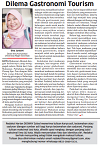Gastronomy Tourism : From Local to Global
The city of Makassar is known for its appetizing cuisine, ranging from Coto Makassar, Pallubasa, to Pisang Epe. Even with Palu City, which is known for its fried onions. Some cities are indeed famous for the food brands that are the city's hallmark. When we talk about traditional cuisine as a brand of localized food, we can start with Yogyakarta with its signature, Gudeg food. So does Semarang, known for its Wingko and spring rolls as a traditional food in this city. Malang is synonymous with meatballs, following the cold weather in apple city. Why is culinary one of the crucial things in the city's branding?
The power of gastronomy as an attraction that reflects a city makes culinary one of the magnets for tourists who want to visit the city. Gastronomic tourism has also been known and popular among young people. Gastronomic tourism serves food tourism, such as street food, and the tour collaborates with socio-cultural elements, where the food becomes the area's identity. Identity suggests that gastronomic tourism can be one of the area's revenues to advance the area. The element of globalization now erodes the locality of local food. This element of globalization makes local foods inferior to foods from outside the area. In fact, culinary is one of the cultural heritages that presents stories of philosophy, history, and ancestral beliefs in food that is characteristic of the region.
The clash between culinary localization and globalization has made people begin to shift the position of traditional food. Food from another country, not local or traditional food from Indonesia, and junk food are now rampant in cities in Indonesia. It can be seen from the big city in Indonesia, such as Surabaya and Jakarta, which reflects the metropolitan side. Jakarta is no longer a city known for its signature Roti Buaya, but Jakarta is starting to be known for its food produced by artists food and served with a typical foreign touch. Not to mention, the emergence of social media has made people, moreover youth, prefer to take pictures of food before eating it. The photograph was published on social media, so taking pictures of the food and post it on Instagram before consumption it, was considered reasonable. Taking picture of their food more important than enjoy food' delicacy.
Gastronomic tourism has two sides. On the one hand, gastronomic tourism can introduce global and modern foods. On the other hand, the local food asidentity of an area will be questioned. Today, in 2023, people in Makassar City still know Coto Makassar and Es Pisang Ijo. What about going forward? Are these appetizing foods still easy to find in metropolitan cities in Eastern Indonesia?***
-Gita Juniarti-
Communication Science, Faculty of Social Science, UNG
Tulisan ini dimuat dalam harian Radar Makassar, 14 Februari 2023

